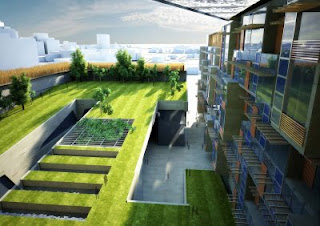 through facebook group talk about gardens, I met a group that dealt with the vertical gardens and ground cover. An exciting world that is surely an important source of employment once this crisis that we are happy to pay and hopefully not long in coming. One way to develop a healthier urban environment and also achieve significant energy savings.
through facebook group talk about gardens, I met a group that dealt with the vertical gardens and ground cover. An exciting world that is surely an important source of employment once this crisis that we are happy to pay and hopefully not long in coming. One way to develop a healthier urban environment and also achieve significant energy savings. This "living painting" isolated from the noise, acts as an effective agent that helps fight environmental pollution and preserves the facade covered in inclement weather.
"Plants do not need land because land is not more than half. Only water and the many nutrients dissolved in it, along with light and carbon dioxide are essential for plants. There where water is never lacking, as in tropical forests, the plants are spread on the trunks of trees, the rocks of the cliffs ...

The bowels vertical garden
The Vertical Garden is composed of three main elements: metal, plastic sheeting and a layer of nylon felt. CaixaForum In the case of Madrid, has a height of 24 meters, a depth of nearly a meter and a length of 19 meters. Is placed slightly away from the façade of the existing building, in order not to transmit any effort.
resulting plant surface extends over 460 square meters. It consists of 15,000 plants of 250 different species. Including Lonicera nitida , Yucca filamentosa, Cistus purpureus, Cedrus deodara, pilosella aurantiaca, Dianthus deltoides, Arenaria montana, Cornus sanguinea, Lonicera pileata, Sedum alpestre, Campanula takesimana, Bergenia cordifolia and Garry elliptica , among other species. Many of them are indigenous, such as deciduous shrub Cornus sanguinea (dogwood red), others are foreign, but adapted well to the climate of Madrid, as Bergenia cordifolia, commonly known as
hydrangea or cabbage or begoña winter, typical of Siberia and Mongolia.
The metal structure
 This is a free-standing vertical structure, 24 meters high and is the foundation upon which rest the auxiliary structure and all elements of the vertical garden. Consists of six main towers and, like the ribs of a boat is involved, a tubular system. A layer of air that acts as a heat and sound insulation very efficient.
This is a free-standing vertical structure, 24 meters high and is the foundation upon which rest the auxiliary structure and all elements of the vertical garden. Consists of six main towers and, like the ribs of a boat is involved, a tubular system. A layer of air that acts as a heat and sound insulation very efficient.
support panel (by clicking this link you will find where to buy it).
It consists of a PVC foam panel subjected to the metal structure. This layer provides rigidity to the whole structure and makes it waterproof.
irrigation layer
formed by a double mat of synthetic fibers and plastic sheeting on the inside, is attached by staples to the support panel. It is the base of support throughout the plantation. Felt is special, so it does not rot, and its huge capillarity allows a homogeneous distribution of water. The plants were distributed throughout this layer of felt (the density is about 30 plants per square meter) and the roots grow along it.
Planting and water supply
Planting is done by inserting the roots of plants without soil, between the two layers of the blanket using staples and fix them.
supply water and nutrients and water harvesting is done through a network of pipes, drip nozzles, and nourished by a water pump and nutrients, which is fixed on the blanket of rooting. The irrigation water enriched with nutrients, is from the top of the structure, and automatic. The water seeps through the wall is collected by a gutter attached to the bottom of the vertical garden. This will solve the problem that could generate excess runoff water.
The result is a vertical garden that recreates a living system like that of nature, and that recalls the ancient Hanging Gardens of Babylon. The total weight, including plants and metal frame, is less than 30 kilos per square meter. Given the low weight, these gardens can develop into any wall, regardless of size or height. Thanks to its thermal insulating effect, reduces energy consumption (in winter, insulate the cold, in summer, acts as a natural cooling system) and clean the air (pollution particles are attracted by the wick, which slowly decompose and remineralizing, thus becoming fertilizer for plants).

Art ecological, eco-art, green architecture
These are some of the names that has received the vertical garden by Patrick Blanc. He prefers to refer to it as "living painting." The French botanist has made more than a hundred worldwide operations, both indoor and outdoor museums and educational spaces, festivals and exhibitions, showrooms and shopping malls, hotels and restaurants apartments, swimming pools, terraces ... Even has enriched the facade of a skyscraper in Kuala Lumpur. Its vertical gardens are present, for example, at the Museum of Modern Art in Kanazawa (Japan), Des Ternes Paris parking, several shops and Marithé Yves Rocher et François Girbaud, the Ethnographic Museum of the Quai Branly in Paris, the Parliament Brussels, the Hotel Byblos Saint-Tropez ... The Vertical Garden CaixaForum Madrid was the first to settle in Spain.
green roofs also have become fashionable. Another way to take gardening to the urban environment. Decorative addition to meeting all functions as has been reported previously endowed a multitude of benefits to the environment.
External sources: jardinactual.com, jardinesverticalesycubier tasvegetales.blospot.com
0 comments:
Post a Comment